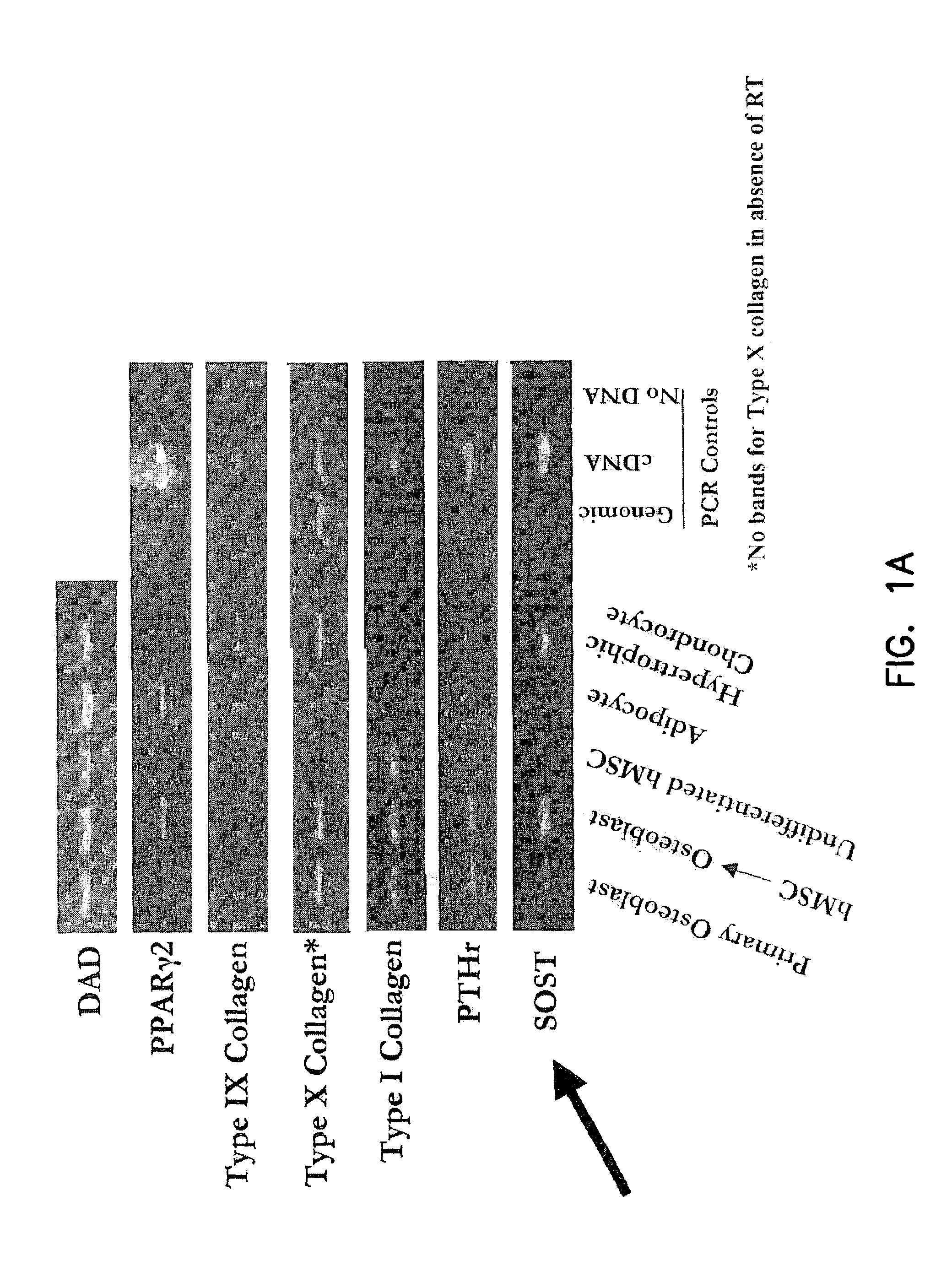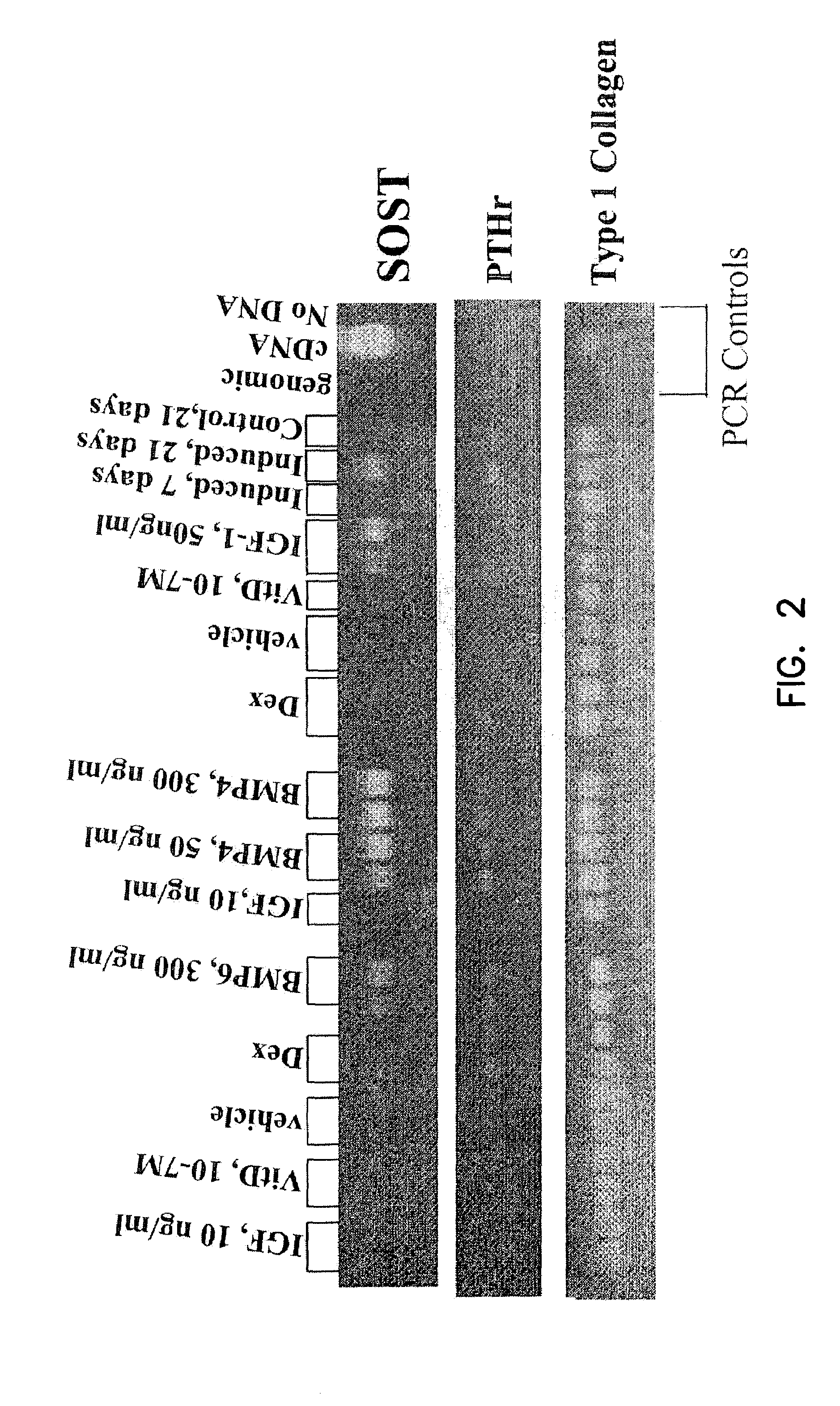Methods to increase or decrease bone density
a bone density and bone density technology, applied in the direction of drug compositions, biological material analysis, dna/rna fragmentation, etc., can solve the problems of increased bone fracture risk of patients with osteoporosis, estrogen replacement therapy can have unwanted side effects, and women are particularly at risk of osteoporosis. , to achieve the effect of reducing the activity of osteoblasts, blocking the ability of osteoprogenitor cells, and increasing the activity of osteoblastic markers
- Summary
- Abstract
- Description
- Claims
- Application Information
AI Technical Summary
Benefits of technology
Problems solved by technology
Method used
Image
Examples
example 1
Expression of SOST Correlates with Commitment and Differentiation of Precursor Cells to Osteogenic Lineage
[0195]In this example, the SOST expression was correlated with cellular differentiation and was found to increase as progenitor cells developed into osteoblasts.
SOST Expression Assay
[0196]Human mesenchymal (hMSC) cells were cultured in regular growth media (Biowhittaker's MSCGM) or Osteoblast-inducing media (Biowhittaker's MSCGM medium supplemented with 100 nM dexamethasone, 50 μg / ml ascorbic acid, and 10 mM β-glycerophosphate). Media were refreshed twice per week. Cultures were harvested 1, 7 and 21 days after plating and RNA isolated for RT-PCR analyses of SOST. SOST expression was also determined in adipocytes and chondrocytes generated from mesenchymal cells cultured for 21 to 28 days in corresponding media (Pittenger et al.). Primary cultures of human osteoblasts were also grown in Osteoblast-inducing media for 21 days and RNA isolated for RT-PCR. SOST expression was also a...
example 2
Regulation of SOST Expression by Growth Factors and Hormones in Human Bone Cells
[0201]In this example, the effect of growth factors and hormones on SOST expression in hMSC cells or primary human osteoblasts was observed using RT-PCR. Prior to measuring SOST expression, these cells were treated for 72 hrs with BMP-2, BMP-4, BMP-6, insulin-like growth factor-1 (IGF-1), parathyroid hormone (PTH), transforming growth factor-β (TGF-β), dexamethasone (DEX), retinoic acid (RA), and 1,25-dihydroxyvitamin D3 (vit D). As immature osteoblasts differentiate and become capable of mineralization, they express markers associated with the osteoblast phenotype (type I collagen and parathyroid hormone receptor (PTHr)). These markers were used to ascertain whether differentiation had occurred so that the influence of growth factors and hormones could be correlated with the stage differentiation as well as the level of SOST expression.
Methods
[0202]Human mesenchymal cells and primary human osteoblasts w...
example 3
Compounds Affecting SOST Expression
[0215]The previous example illustrates that SOST expression was enhanced by bone morphogenetic proteins and modulated by steroids such as dexamethasone. In this example, human MSC cells were incubated with bone morphogenetic proteins in the presence of various test agents to determine whether other steroids and compounds could affect the BMP-induction of SOST. SOST expression was monitored by reverse transcriptase polymerase chain reaction (RT-PCR).
Materials and Methods
[0216]Human mesenchymal cells (hMSCs) were plated in regular growth media containing 2% FCS and treated with BMP-6 either alone or in combination with the test compounds. The cells were harvested 72 hrs later and RNA was prepared for RT-PCR analysis of SOST expression.
Results
[0217]The compounds tested and the results obtained for these compounds are summarized in Table 1.
[0218]
TABLE 1CompoundConcentrationCompoundSourceTypeTestedResultsDexamethasoneSIGMA-Glucocorticoid1 × 10−7 MInhibi...
PUM
| Property | Measurement | Unit |
|---|---|---|
| concentrations | aaaaa | aaaaa |
| temperature | aaaaa | aaaaa |
| temperatures | aaaaa | aaaaa |
Abstract
Description
Claims
Application Information
 Login to View More
Login to View More - R&D
- Intellectual Property
- Life Sciences
- Materials
- Tech Scout
- Unparalleled Data Quality
- Higher Quality Content
- 60% Fewer Hallucinations
Browse by: Latest US Patents, China's latest patents, Technical Efficacy Thesaurus, Application Domain, Technology Topic, Popular Technical Reports.
© 2025 PatSnap. All rights reserved.Legal|Privacy policy|Modern Slavery Act Transparency Statement|Sitemap|About US| Contact US: help@patsnap.com



